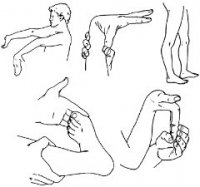http://en.wikipedia.org/wiki/Ehlers%E2%80%93Danlos_syndrome
Ehlers–Danlos syndrome
From Wikipedia, the free encyclopedia
| Ehlers-Danlos Syndrome | |
|---|---|
| Classification and external resources | |
 | |
| ICD-10 | Q79.6 (ILDS Q82.817) |
| ICD-9 | 756.83 |
| MedlinePlus | 001468 |
| eMedicine | derm/696 ped/654 |
| MeSH | D004535 |
The syndrome is named after two doctors, Edvard Ehlers of Denmark, and Henri-Alexandre Danlos of France, who identified it at the turn of the 20th century.[3]
Classification
In the past, there were more than 10 recognized types of Ehlers-Danlos syndrome. In 1997, researchers proposed a simpler classification that reduced the number of major types to six and gave them descriptive names.[4] These six major types are listed here. Other types of the condition may exist, but they have been reported only in single families or are not well characterized. Except for hypermobility, the specific mutations involved have been identified and they can be precisely identified by genetic testing; this is valuable due to a great deal of variation in individual presentation of symptoms which may confuse classification of individuals on purely symptomatic basis. In order of prevalence in the population, they are:| Name | Number | Description | OMIM | Gene(s) |
| Hypermobility | type 3 | Affects 1 in 10,000 to 15,000 and is caused by an autosomal dominant or autosomal recessive mechanism. Mutations in either of two separate genes (which are also involved in Vascular EDS and Tenascin-X deficiency EDS, respectively) may lead to this variant. Extreme flexibility is the hallmark of this type. | 130020 | COL3A1, TNXB |
| Classical | types 1 & 2 | Affects approximately 2 to 5 in 100,000 people. It is caused by autosomal dominant mechanism and affects type-V collagen, as well as type I. Type 1 typically presents with severe skin involvement, and type 2 presents with mild to moderate skin involvement. | 130000, 130010 | COL5A1, COL5A2, COL1A1 |
| Vascular | type 4 | Is an autosomal dominant defect in the type-III collagen synthesis; affecting approximately 1 in 100,000 to 250,000 people. The vascular type is considered one of the more serious forms of Ehlers-Danlos syndrome because blood vessels and organs are more prone to tearing (rupture). Patients with EDS type 4 often express a characteristic facial appearance (large eyes, small chin, thin nose and lips, lobeless ears), have a small stature with a slim build, and typically have thin, pale, translucent skin (veins can usually be seen on the chest and abdomen). About one in four people with vascular type EDS develop a significant health problem by age 20 and more than 80 percent develop life-threatening complications by age 40. | 130050 | COL3A1 |
| Kyphoscoliosis | type 6 | Is an autosomal recessive defect due to deficiency of an enzyme called lysyl hydroxylase; it is very rare, with fewer than 60 cases reported. The kyphoscoliosis type is characterised by progressive curvature of the spine (scoliosis), fragile eyes, and severe muscle weakness. | 225400, 229200 | PLOD1 |
| Arthrochalasis | types 7A & B | Is also very rare, with about 30 cases reported. It affects type-I collagen. The arthrochalasia type is characterised by very loose joints and dislocations involving both hips. | 130060 | COL1A1, COL1A2 |
| Dermatosparaxis | type 7C | Also very rare, with about 10 cases reported. The dermatosparaxis type is characterised by extremely fragile and sagging skin. |
Other types
Although the above classifications are well defined, it is rare for a case to fit neatly in a single category, and cross-over symptoms lead to under-diagnosis or mis-diagnosis. So patients should not rely on the "fact" of having a certain type of EDS if cross-over symptoms are evident and might be life-threatening."The large number of distinct types of the Ehlers-Danlos syndrome that have already been identified indicates great heterogeneity, but clearly that heterogeneity is not exhausted by the present classification." [8] Forms of EDS within this category may present with soft, mildly stretchable skin, shortened bones, chronic diarrhea, joint hypermobility and dislocation, bladder rupture, or poor wound healing. Inheritance patterns within this group include X-linked recessive, autosomal dominant, and autosomal recessive. Examples of types of related syndromes other than those above reported in the medical literature include:
Signs and symptoms
 |  | |
| Individual with EDS displaying hypermobile joints. | ||
- Highly flexible fingers and toes
- Loose, unstable joints that are prone to: sprain, dislocation, subluxation (partial dislocation) and hyperextension (double jointedness) [5]
- Flat feet
- High and narrow palate, a sign, resulting in dental crowding
- Easy bruising
- Fragile blood vessels resulting from cystic medial necrosis with tendency towards aneurysm (even abdominal aortic aneurysm)
- Velvety-smooth skin which may be stretchy
- Abnormal wound healing and scar formation
- Low muscle tone and Muscle weakness
- Early onset of osteoarthritis
- Cardiac effects: Dysautonomia typically accompanied by Valvular heart disease (such as mitral valve prolapse, which creates an increased risk for infective endocarditis during surgery, as well as possibly progressing to a life-threatening degree of severity of the prognosis of mitral valve prolapse) [6]
- Fibromyalgia symptoms: Myalgia and arthralgia[7]
- Osteopenia (low bone density)
- Talipes equinovarus (club foot), especially in the Vascular type
- Deformities of the spine, such as: Scoliosis (curvature of the spine), Kyphosis (a thoracic hump), Tethered spinal cord syndrome, Occipitoatlantoaxial hypermobility,[8] Arnold-Chiari malformation (brain disorder)[9]
- Functional bowel disorders (functional gastritis, irritable bowel syndrome)
- Nerve compression disorders (carpal tunnel syndrome, acroparesthesia, neuropathy) [10]
- Vascular skin conditions: Raynaud's phenomenon, Livedo reticularis
- otosclerosisUniversity of Washington Medicine (hearing loss) [11]
- Premature rupture of membranes during pregnancy
- Platelet aggregation failure (platelets do not clump together properly) [12]
- Infants with hypermobile joints often appear to have weak muscle tone (hypotonia), which can delay the development of motor skills such as sitting, standing, and walking
- Arterial/intestinal/uterine fragility or rupture
- Swan neck deformity of the fingers [13]


